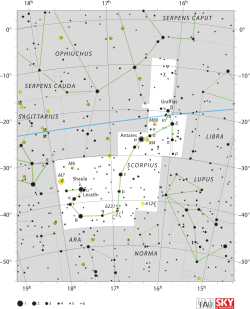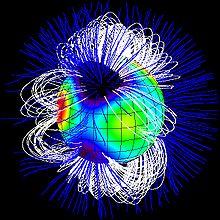
| |
| Observation data Epoch J2000 Equinox J2000 | |
|---|---|
| Constellation | Scorpius |
| Right ascension | 16 35 52.95285 |
| Declination | −28° 12′ 57.6615″ |
| Apparent magnitude (V) | +2.82 |
| Characteristics | |
| Spectral type | B0.2 V |
| U−B color index | −1.039 |
| B−V color index | −0.252 |
| Astrometry | |
| Radial velocity (Rv) | +2.0 km/s |
| Proper motion (μ) | RA: −9.89 mas/yr Dec.: −22.83 mas/yr |
| Parallax (π) | 6.88 ± 0.53 mas |
| Distance | 470 ± 40 ly (150 ± 10 pc) |
| Absolute magnitude (MV) | −4.2 |
| Details | |
| Mass | 15.0±0.1, 14.5–14.7 M☉ |
| Radius | 6.5 R☉ |
| Luminosity | 20,400 L☉ |
| Surface gravity (log g) | 4.24 cgs |
| Temperature | 31,440, 29,850 K |
| Metallicity | −0.14 dex |
| Rotation | 41 days |
| Rotational velocity (v sin i) | 24 km/s |
| Age | 5.7±1.0, 5 Myr |
| Other designations | |
| Paikauhale, Alniyat, Al Niyat, τ Sco, 23 Sco, FK5 620, GC 22303, HD 149438, HIP 81266, HR 6165, SAO 184481 | |
| Database references | |
| SIMBAD | data |
Tau Scorpii, Latinized from τ Scorpii, formally known as Paikauhale /ˌpaɪkaʊˈhɑːleɪ/, is a star in the southern zodiac constellation of Scorpius. The apparent visual magnitude of Tau Scorpii is +2.8, while parallax measurements yield a distance estimate of roughly 470 light-years (150 parsecs) from Earth.
Description

Compared to the Sun, Tau Scorpii is a massive OB star with 15 times the Sun's mass and more than six times the radius of the Sun. It is radiating about 20,400 times the Sun's luminosity from its outer envelope at an effective temperature of 31,440 K. This gives it the blue-white hue characteristic of B-type stars. As yet there is no evidence of a companion in orbit around τ Sco. It is a magnetic star whose surface magnetic field was mapped by means of Zeeman–Doppler imaging. Tau Scorpii is rotating relatively slowly with a period of 41 days.
The spectrum of this star shows triply ionized oxygen (O IV) that is being generated by X-rays and the Auger ionization effect. Observations with the ROSAT space telescope showed it has a higher energy (harder) X-ray spectrum than is usual for B0 V stars. Over the energy range 0.8–1.2 keV, its X-ray luminosity is Lx = 1.8 × 10 erg s with a large Lx to Lbol of log Lx/Lbol = –6.53 from ASCA measurements. ROSAT measurements showed a log Lx/Lbol ≃ –5.93 for the range 0.1–2.4 keV. The hard component of the X-ray spectrum from τ Sco as studied with XMM-Newton supports the presence of in-falling clumps of plasma in τ Sco.
This star is a proper motion member of the Upper Scorpius subgroup of the Scorpius–Centaurus OB association, the nearest such co-moving association of massive stars to the Sun. The Upper Scorpius subgroup contains thousands of young stars with mean age 11 million years at average distance of 470 light years (145 parsecs) A more recent analysis of the HR diagram position for Tau Scorpii estimates its effective temperature to be 29,850 K with a luminosity of 20,400 L☉, consistent with an isochronal age of 5 million years and an estimated mass of 14.5–14.7 solar masses.
Nomenclature
τ Scorpii (Latinised to Tau Scorpii) is the star's Bayer designation.
Tau Scorpii and Sigma Scorpii together bore the traditional name Al Niyat (or Alniyat) derived from the Arabic النياط al-niyāţ "the arteries" and referring to their position flanking the star Antares, the scorpion's heart, with Tau Scorpii being the star to the south.
Paikauhale is the Hawaiian name for Tau Scorpii. In the Hawaiian dictionary by Pukuʻi & Elbert (1986), the word paikauhale [ˈpəiˈkəuˈhale] is defined as to go gadding about from house to house. In another Hawaiian dictionary (H.W. Kent, 1993, "Treasury of Hawaiian Words in One Hundred and One Categories", p.367), paikauhale is defined as Vagabond owning no home; house-to-house wanderer.
In 2016, the IAU organized a Working Group on Star Names (WGSN) to catalog and standardize proper names for stars. The WGSN approved the name Paikauhale for the star A on 10 August 2018 and it is now so included in the List of IAU-approved Star Names. The name Alniyat was given to Sigma Scorpii.
Cultural signification
The indigenous Boorong people of northwestern Victoria saw this star (together with σ Sco) as wives of Djuit (Antares).
In Chinese, 心宿 (Xīn Xiù), meaning Heart, refers to an asterism consisting of τ Scorpii, σ Scorpii and Antares. Consequently, the Chinese name for τ Scorpii itself is 心宿三 (Xīn Xiù sān), "the Third Star of Heart".
References
- ^ van Leeuwen, F. (November 2007), "Validation of the new Hipparcos reduction", Astronomy and Astrophysics, 474 (2): 653–664, arXiv:0708.1752, Bibcode:2007A&A...474..653V, doi:10.1051/0004-6361:20078357, S2CID 18759600
- ^ Gutierrez-Moreno, Adelina; Moreno, Hugo (June 1968), "A Photometric Investigation of the Scorpio-Centaurus Association", Astrophysical Journal Supplement, 15: 459, Bibcode:1968ApJS...15..459G, doi:10.1086/190168
- ^ Howk, J. Christopher; et al. (May 2000), "Stagnation and Infall of Dense Clumps in the Stellar Wind of τ Scorpii", The Astrophysical Journal, 534 (1): 348–358, arXiv:astro-ph/9912360, Bibcode:2000ApJ...534..348H, doi:10.1086/308730, S2CID 14115701
- Wielen, R.; et al. (1999), "Sixth Catalogue of Fundamental Stars (FK6). Part I. Basic fundamental stars with direct solutions", Veroeffentlichungen des Astronomischen Rechen-Instituts Heidelberg, 35 (35): 1, Bibcode:1999VeARI..35....1W
- ^ de Geus, E. J.; de Zeeuw, P. T.; Lub, J. (June 1989), "Physical parameters of stars in the Scorpio-Centaurus OB association", Astronomy and Astrophysics, 216 (1–2): 44–61, Bibcode:1989A&A...216...44D
- ^ Tetzlaff, N.; Neuhäuser, R.; Hohle, M. M. (January 2011), "A catalogue of young runaway Hipparcos stars within 3 kpc from the Sun", Monthly Notices of the Royal Astronomical Society, 410 (1): 190–200, arXiv:1007.4883, Bibcode:2011MNRAS.410..190T, doi:10.1111/j.1365-2966.2010.17434.x, S2CID 118629873
- ^ Mark J. Pecaut; et al. (February 2012). "A Revised Age for Upper Scorpius and the Star Formation History among the F-type Members of the Scorpius–Centaurus OB Association". Astrophysical Journal. 746 (2): 154. arXiv:1112.1695. Bibcode:2012ApJ...746..154P. doi:10.1088/0004-637X/746/2/154. S2CID 118461108.
- ^ Kilian, J. (February 1994), "Chemical abundances in early B-type stars. 5: Metal abundances and LTE/NLTE comparison", Astronomy and Astrophysics, 282 (3): 867–873, Bibcode:1994A&A...282..867K
- ^ Zorec, J.; et al. (July 2009), "Fundamental parameters of B supergiants from the BCD system. I. Calibration of the (λ_1, D) parameters into Teff", Astronomy and Astrophysics, 501 (1): 297–320, arXiv:0903.5134, Bibcode:2009A&A...501..297Z, doi:10.1051/0004-6361/200811147, S2CID 14969137
- ^ Strassmeier, Klaus G. (September 2009), "Starspots", The Astronomy and Astrophysics Review, 17 (3): 251–308, Bibcode:2009A&ARv..17..251S, doi:10.1007/s00159-009-0020-6
- 6165, database entry, The Bright Star Catalogue, 5th Revised Ed. (Preliminary Version), D. Hoffleit and W. H. Warren, Jr., CDS ID . Accessed on line February 8, 2013.
- "tau Sco -- Star", SIMBAD, Centre de Données astronomiques de Strasbourg, retrieved 2010-08-01
- "The Colour of Stars", Australia Telescope, Outreach and Education, Commonwealth Scientific and Industrial Research Organisation, December 21, 2004, archived from the original on 2013-12-03, retrieved 2012-01-16
- ^ Mewe, R.; et al. (2003), "High-resolution X-ray spectroscopy of τ Scorpii (B0.2V) with XMM-Newton" (PDF), Astronomy & Astrophysics, 398 (1): 203–11, Bibcode:2003A&A...398..203M, doi:10.1051/0004-6361:20021577
- Donati, J.-F.; et al. (2006), "The surprising magnetic topology of τ Sco: fossil remnant or dynamo output?", Monthly Notices of the Royal Astronomical Society, 370 (2): 629–644, arXiv:astro-ph/0606156, Bibcode:2006MNRAS.370..629D, doi:10.1111/j.1365-2966.2006.10558.x, S2CID 7054292
- Allen, Richard Hinckley (1963) . Star Names: Their Lore and Meaning (Reprint ed.). New York, NY: Dover Publications Inc. p. 371. ISBN 0-486-21079-0.
- Kawena, Johnson, & Ruggles, 2015, "Na Inoa Hoku: Hawaiian and Pacific Star Names", p.201
- Puku'i & Elbert, 1986, "Hawaiian Dictionary: Hawaiian-English, English-Hawaiian", p.31
- "IAU Working Group on Star Names (WGSN)". Retrieved 17 September 2018.
- "IAU Catalog of Star Names". International Astronomical Union. Retrieved 2018-09-17.
- Hamacher, Duane W.; et al. (2010). "An Aboriginal Australian Record of the Great Eruption of Eta Carinae". Journal of Astronomical History & Heritage. 13 (3): 220–34. arXiv:1010.4610. Bibcode:2010JAHH...13..220H. doi:10.3724/SP.J.1440-2807.2010.03.06. S2CID 118454721.
- (in Chinese) 中國星座神話, written by 陳久金. Published by 台灣書房出版有限公司, 2005, ISBN 978-986-7332-25-7.
- (in Chinese) 香港太空館 - 研究資源 - 亮星中英對照表 Archived 2008-10-25 at the Wayback Machine, Hong Kong Space Museum. Accessed on line November 23, 2010.